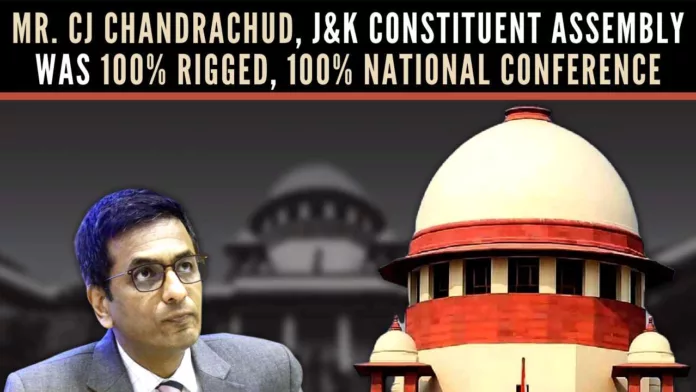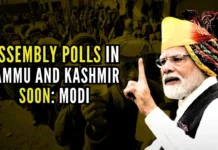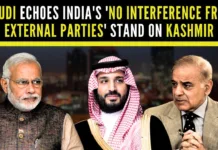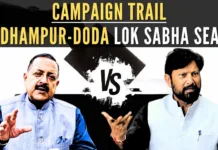
SC hearing on Article 370 abrogation
Hearing is on in the Supreme Court (SC) on August 5, 2019, the Narendra Modi government’s epoch-making decision to read down seditious Article 370, abrogate discriminatory and illegal Article 35A and bifurcate Jammu and Kashmir (J&K) into two union territories. It has already taken place on August 2, 3, 8, 9 and 10. The SC will again take up the petitions filed against the Union government’s decision on August 16 and thereafter. The number of petitioners is 23 and some of them include the protagonists of greater autonomy/ self-rule/ limited accession or semi-independence/ Indo-Pak joint-control over J&K the Kashmir-based National Conference (NC), People’s Democratic Party (PDP), People’s Conference (PC), J&K High Court Bar Association (Kashmir Unit) and Communist Party of India Marxist (CPIM); and their Delhi-based supporters.
Spurious argument
One thing that became crystal clear from the arguments advanced by the petitioners’ lawyers – Kapil Sibal, Gopal Subramanium, and Zaffar Shah – is that they all tried to convince the CJI D Y Chandrachud-headed five-judge constitutional bench that the J&K Constituent Assembly, which ceased to exist on January 26, 1957, after the enforcement of the J&K Constitution that day, alone had the power to recommend abrogation of Article 370, or recommend withdrawal of the J&K special status. In other words, the petitioners’ lawyers told the constitutional bench that neither the President of India nor the Modi government and Indian Parliament had the authority to do what it did on August 5, 2019, and that what it did was illegal, unconstitutional and against the cardinal principles of federalism.
100% rigged Constituent Assembly
Which Constituent Assembly Kapil Sibal, Gopal Subramanium, and Zaffar Shah talked about? That Constituent Assembly which was 100% rigged and all-NC or 100% NC? It was 100% rigged or unelected Constituent Assembly. Even a Kashmiri Muslim social scientist of Kashmir University Aijaz Wani, has acknowledged that it was 100% unelected and 100% NC.
Let me quote what Wani has written in his essay “Electoral politics in Jammu and Kashmir and the problem of communal polarization” in this regard. He has written: “In 1951, the NC government began preparations to convene a constituent assembly in Srinagar despite the pressures from the UN against the decision. A seventy-five-member Constituent Assembly was elected, theoretically on the basis of universal adult franchise. NC won all seventy-five seats uncontested, the first instance of Indian-administered Kashmir’s sorry history of utterly farcical elections. There was no question of anyone opposing NC in the Valley, where Abdullah was running a virtual party-state. But no contest was permitted even in Jammu where the Praja Parishad, a ‘Hindu nationalist’ group, was arbitrarily prevented from participating in the polls. The manner in which this election was conducted made a mockery of any pretense of a democratic process and set a grim precedent for future free and fair elections in J&K. This process of denying democracy continued with the full backing of the centre (in this case JL Nehru government), leading to the turning of semi-loyal opposition within the valley into a completely disloyal opposition and, in Jammu and Ladakh, mobilization on communal lines leading to demands of a complete merger with the Indian by the Hindus of Jammu and Union Territory states by Buddhists of Ladakh” (Mujibur Rehman (editor), Rise of Saffron power: Reflections on Indian politics, First South Asia edition, New York, 2018).
And Wani’s whole conclusion was based on the works of Sumantara Bose (The Challenge in Kashmir), Balraj Puri (Kashmir Towards Insurgency), and P N Bajaj (Kashmir in Crucible). Bose, Puri, and Bajaj are all supporters of Kashmiri Muslim sub-nationalism and votary of maximum autonomy to J&K.
Nehru-Sheikh hatched the conspiracy to hurt Jammu
Indian Prime Minister Nehru and J&K Wazir-e-Azam Sheikh Abdullah not only hatched conspiracies against the nation to drive J&K away from the national mainstream through obnoxious Article 370 and constitute a sham Constituent Assembly. They also hatched a conspiracy to render Jammu province unreal and ineffective for all practical purposes by giving a preponderant share of representation in the Constituent Assembly to a tiny part of the state, Kashmir. Kashmir was given 43 seats in the 75-member Assembly, Jammu only 30, and Ladakh a paltry two, despite the fact that Jammu’s land area was two-time that of Kashmir and housed more population as compared to Kashmir.
That the population of Jammu province was more as compared to Kashmir could be seen from the fact that the number of voters in Jammu province as late as 2001 was “1.8 lakh” more than Kashmir[1]. It is universally accepted that the more the population, the more the number of voters.
Nehru subverted rules to subvert democracy
Earlier on May 27, 1949, the anti-democratic Nehru government subverted paragraph 4 of the Indian Constituent Assembly Rules to deny the people of J&K the right to return representatives of their choice to the Indian Constituent Assembly and snatched from Maharaja Hari Singh his power to nominate two members of his choice to the Indian Constituent Assembly. Paragraph 4 said that the ruler of the princely state shall nominate 50 percent persons to the Indian Constituent Assembly and the remaining 50% seats will be filled through election by people. But the Nehru government threw all these rules to the wind and made the Constituent Assembly adopt the amendment under which “all the seats in the Assembly allotted to the State of (Jammu and) Kashmir may be filled by nomination and the representatives of the state to be chosen to fill such seats may be nominated by the ruler of (Jammu and) Kashmir on the advice of (Sheikh Abdullah) his Prime Minister”.
The immediate fallout was the entry of Sheikh Abdullah and his nominees, Mirza Afzal Beg, Moulana Masoodi, and Moti Ram Baigra. (Constituent Assembly Debates, Book No. 3, Vol. VIII, May 16, 1949, to June 16, 1949, Second Reprint, 1989, PP. 357-373).
Matter of satisfaction
It’s a matter of great satisfaction that CJ Chandrachud has told Kapil Sibal and ilk that the “Constituent Assembly cannot have an indefinite life”. However, the five-judge Constitutional Bench would do well to see what the murderers of democracy – Nehru and Sheikh – did in May 1949 and in 1951 to muddy the Indian waters in J&K, subvert democratic principles, subvert the laid down rules and regulations and render the people of Jammu province unreal and ineffective.
Note:
1. Text in Blue points to additional data on the topic.
2. The views expressed here are those of the author and do not necessarily represent or reflect the views of PGurus.
Reference:
[1] India’s failure in Kashmir – Jul 22, 2015, Frontline, The Hindu
PGurus is now on Telegram. Click here to join our channel and stay updated with all the latest news and views
For all the latest updates, download PGurus App.
- ‘Kashmir My core constituency’: Revisiting July 12, 2003 to understand politics, Omar Abdullah-style - March 15, 2024
- Total deviation from traditional approach: Seven takeaways from PM Modi’s March 7 Srinagar visit - March 9, 2024
- Status of political parties: Why is further J&K reorganization imperative? - March 1, 2024











An important article which throws light on this sordid chapter of our history.